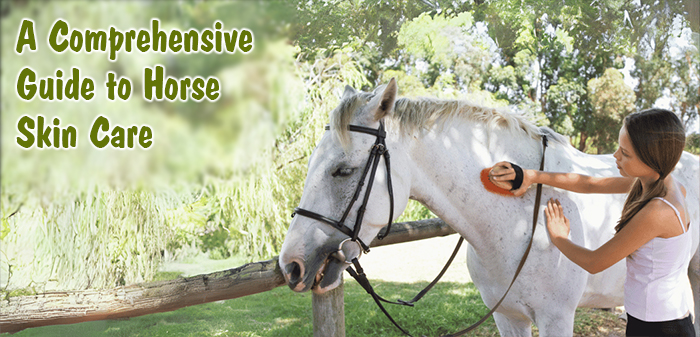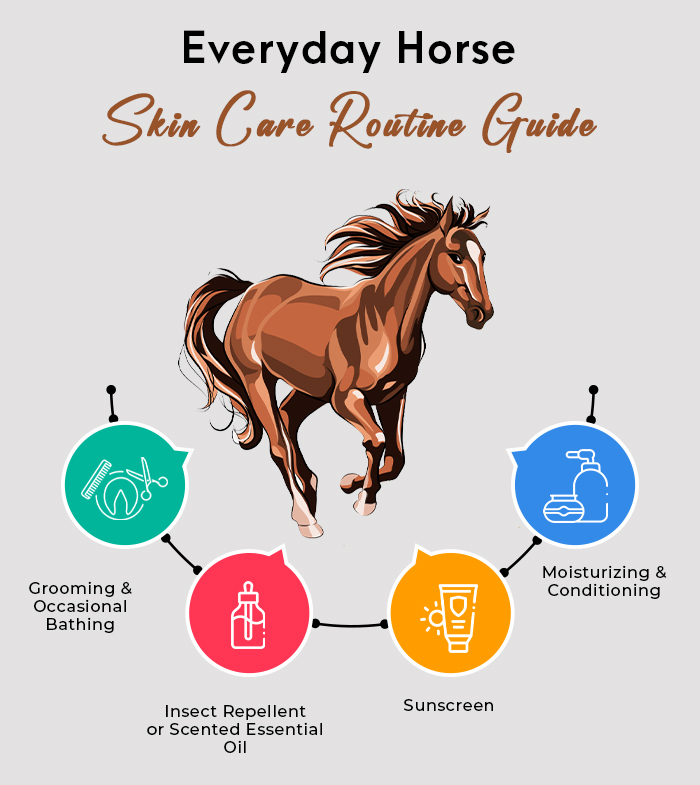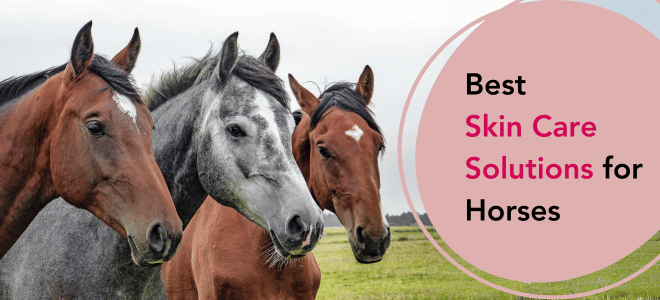A Comprehensive Guide to Horse Skin Care

A horse’s skin and coat are windows to the overall health of the horse. Their skin and coat conditions also tell much about their caretakers, like how they care for their equine companions. Moreover, the skin and hair play a vital role in protecting the body from external elements and maintaining overall health. This is why, it is paramount for every horse parent to take good care of their skin and coat.
This guide will provide valuable tips to help you ensure your horse’s skin remains healthy and problem-free.
Why Horse Skin Care Is Important
Like every other animal, the skin is the largest organ in horses too. The condition of the skin and hair significantly affects their overall health.
Following are a few reasons why skincare should be a priority for horse parents:
- Protection from the external elements: The skin plays a vital role in protecting against external irritants like dirt, bacteria, viruses, etc. Horses are constantly exposed to sunlight, harsh weather conditions, mud, dirt, etc. With proper skin care, you can foster their protective barrier and reduce the risk of infections and discomfort.
- Prevention of skin problems: A horse’s skin is prone to various skin problems and infections, including sweet itch, warts, ringworm, rain rot, etc. These problems can severely affect your horse’s health. With regular grooming and skincare routines, you can prevent these infections from occurring in the first place.
- Enhanced comfort and well-being: As already mentioned, the skin and coat are the windows to a horse’s overall health. With proper grooming and skin care practices, you can not only keep your horse’s skin clean but also provide them comfort. Additionally, it nourishes their skin and coat, promoting a healthy and shiny appearance.
How to Take Care of Your Horse’s Skin
Ensuring your horse’s healthy skin and coat takes conscious and consistent efforts. It requires a holistic approach involving a balanced diet, a horse skin care routine, a clean environment, and regular vet visits. Let’s take a deeper look:
A. Start With a Balanced Diet
The first step in ensuring healthy skin and coat for your horse is to provide them with a balanced diet. A balanced diet will help them maintain weight and support their daily activities. In addition to vital and essential nutrients, their diet must contain omega-3 fatty acids and antioxidants, which are crucial for healthy skin and coat health.
Vets suggest adequate protein is also important for maintaining optimal skin and coat health in horses. A growing horse’s diet must contain 14–16% protein, while a mature horse’s diet should have 8–12% protein. Trace elements like zinc and copper are also essential. One must consult with a vet to ensure the optimal diet for their horses.
B. Follow a Skincare Routine
A horse’s skincare routine is essential for maintaining the skin and coat’s health as well as overall well-being. However, doing so can be challenging without proper knowledge and guidance.
The following tips will help you create an effective skincare routine for your horses.
Note for SEO: I am highlighting some product categories in the text that can be used to hyperlink products.
Step 1: Bathing
Bathing is an integral part of the horse’s skincare routine. It helps you clean up the dirt buildup and sweat from the horse’s hair and coat. An antifungal shampoo and conditioner can help you deeply cleanse their hair and fur and eliminate the risk of fungal and bacterial infections.
However, don’t shampoo your horse every day. Daily shampooing can deplete the natural oils from your horse’s skin and hair. It is best to give 1 or 2 shampoo baths every 15 days.
Step 2: Grooming
Grooming should be part of the everyday horse skincare routine. Regular grooming helps remove dirt and dead cells from the hair and coat and stimulates hair oil production. Furthermore, it helps manage various skin issues, such as dermatitis and cannon seborrhea (scurfy, scaly skin, and hair loss over the front of the cannon region of both hind limbs). Moreover, daily grooming allows you to inspect your horse’s skin for abnormalities or injuries. This can help you quickly catch any potential issues and seek appropriate treatment.
Additionally, make sure you use separate grooming kits for each horse. Fungal infections are often spread using common grooming brushes or tools on multiple horses. You can minimize the risk of spreading infections using separate grooming kits and keep each horse’s skin healthy.
Step 3: Sunscreen
Like us, horses are also prone to sunburn, especially in their pink and lighter-colored skin areas, such as the nose, ears, and around the eyes. Applying sunscreen to these areas can help protect them from harmful ultraviolet rays and prevent sunburn.
Using sunscreen sprays or wipes, you can provide a protective barrier for your horse’s delicate skin areas and save them from the discomfort caused by sunburn.
Step 4: Insect Repellent
Pests are the most harmful and troublesome enemy of your horse’s skin and coat. Bugs, fleas, and ticks can cause significant discomfort infestations that can lead to allergies and the transmission of diseases. You can keep these pests away and protect your horses from potential harm using insect repellent sprays, such as flea and tick deterrent sprays. This also acts as your horses’ first line of defense, improving their skin immunity.
Step 5: Conditioning and Moisturizing
When horses are exposed to the sun for prolonged periods, they not only get sunburns, but it also leads to dried skin. This can lead to itchy and damaged skin. However, using a moisturizer and conditioner spray can improve the horse’s skin and make it healthier.
In the long term, moisturizers and conditioners also improve the hair coat, making it shinier and lustrous. It also helps reduce oil and dirt buildup on the skin and coat.
Also Read: Skin Disorders and Treatments in Horses
Everyday Horse Skin Care Routine Guide
To promote a healthy skin and coat, you should also follow a particular skincare routine for your horses. Take a look:

- Start with grooming your horse. If you find excessive dirt buildup on their hair and coat, a deep cleansing shampoo bath will help.
- Now, apply moisturizer and conditioner spray to their hair and coat.
- Then, apply sunscreen to their pink and lighter-haired areas and other exposed skin areas.
- Finally, spray an insect repellent or scented essential oil onto your horse’s hair and coat.
C. Keep Stable Clean
Your horse’s stable is their home and is vital to their overall health, including their skin and coat condition. If it is not clean or is infested with insects and pests, it can pose a significant risk to their skin and coat health and overall well-being.
Cleaning their stable every day by using pest control products occasionally can help you avoid many health problems with horses. Maintaining hygiene also ensures that their stable is free from bugs, fleas, ticks, and other harmful pests. Mud and soggy floors can encourage bacterial and fungal infections, so keeping the stable floor dry and well-drained is crucial.
You can avoid these issues by regularly removing the manure and wet bedding. Additionally, provide proper ventilation; this will help maintain proper humidity and the internal environment.
Finally, ensure the fencing is safe and secure to prevent any accidents or injuries to the horses. Anything that can cause a puncture wound, laceration, or other skin injury should be taken care of.
D. Regular Vet Visits
Lastly, regular vet visits are important for maintaining your horse’s healthy skin. During these visits, the vet can check for skin conditions or infections that may not be visible to the naked eye.
They can treat and control those skin conditions or infections before they worsen or cause discomfort for your horse. A vet can also guide you on proper grooming techniques and recommend grooming products best suited to your horse’s health needs.
Bottom Line
Like humans, horses also need skin care for comfort, well-being, and optimal overall health. By following the tips outlined in this article, you can ensure that your horse’s skin and coat are healthy, shiny, and lustrous.


